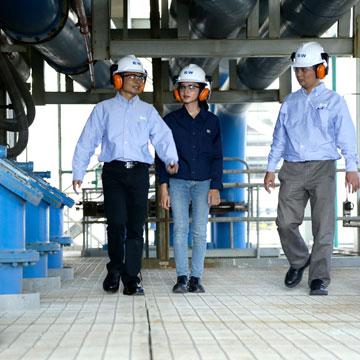Babcock & Wilcox existe pour CO2llaborer avec pour objectif unique d’aider les clients à créer une énergie plus propre. Pour ce faire, nous utilisons des technologies de décarbonisation éprouvées et des innovations en matière de production d’énergie et de contrôle des émissions. B&W fait figure de leader, d’innovateur et de défenseur de la réduction des gaz à effet de serre. Nous intervenons de la sorte dans trois segments connexes :
Nous transformons notre monde depuis plus de 150 ans
Babcock & Wilcox (B&W) a vu le jour en 1867 avec un brevet, deux amis et un engagement indéfectible envers l’innovation fiable et efficace. Lorsque Stephen Wilcox a déclaré pour la première fois « qu’il devait y avoir un meilleur moyen » de produire de l’énergie en toute sécurité, ce dernier et George Babcock ont décidé de concevoir la première chaudière à tubes d’eau intrinsèquement sûre : la société était née. Ce défi d’amélioration continue perdure aujourd’hui.
Nous nous sommes développés à travers les industries et les continents. Nous avons diversifié les outils que nous utilisons et les technologies que nous proposons. Une chose qui n’a pas changé et ne changera jamais, c’est notre engagement à concevoir un meilleur moyen. C’est ainsi que nous transformons notre monde.
Décarbonisation pour un avenir net zéro
Aujourd’hui, nous développons de nouvelles technologies pour la transition énergétique émergente et en cours.
Le monde veut que les choses changent. Plus de 100 pays se sont engagés à atteindre un objectif de zéro carbone d’ici le milieu du siècle. Étant donné que nous approchons de la moitié de cette échéance, nous ne pouvons pas relâcher nos efforts.
Lauréat de plus de 90 brevets pour la capture du carbone au cours de ces quatre dernières décennies, Babcock & Wilcox fait figure de leader dans le domaine de la recherche et du développement liés à la décarbonisation. Nos technologies révolutionnaires de décarbonisation ClimateBright™ peuvent séparer efficacement le CO2 tout en produisant de l’hydrogène, de la vapeur et/ou du gaz de synthèse. Elles s’appliquent également à un large éventail d’industries, notamment la production d’énergie, la fabrication d’aliments, l’acier, le ciment, le pétrole et le gaz, la pharmacie, la pétrochimie, le noir de carbone et les pâtes et papiers. Nous devons CO2llaborer pour la décarbonisation.
Services après-vente intelligents
B&W relève les défis les plus difficiles de nos clients. Du concept et de la mise en service à la maintenance et aux modifications, nous sommes là à chaque étape du processus pour que votre équipement, quel que soit le fabricant d’origine, fonctionne de manière sûre, fiable et efficace.
- Mise à niveau et modernisation des composants et des systèmes
- Évaluation de l’état de l’équipement
- Examens d’efficacité
- Dépannage des performances et des équipements
- Services d’ingénierie sur le terrain
- Assistance en cas de panne
- Pièces détachées et de rechange
- Démarrage et mise en service
- Maintenance courante et préventive




